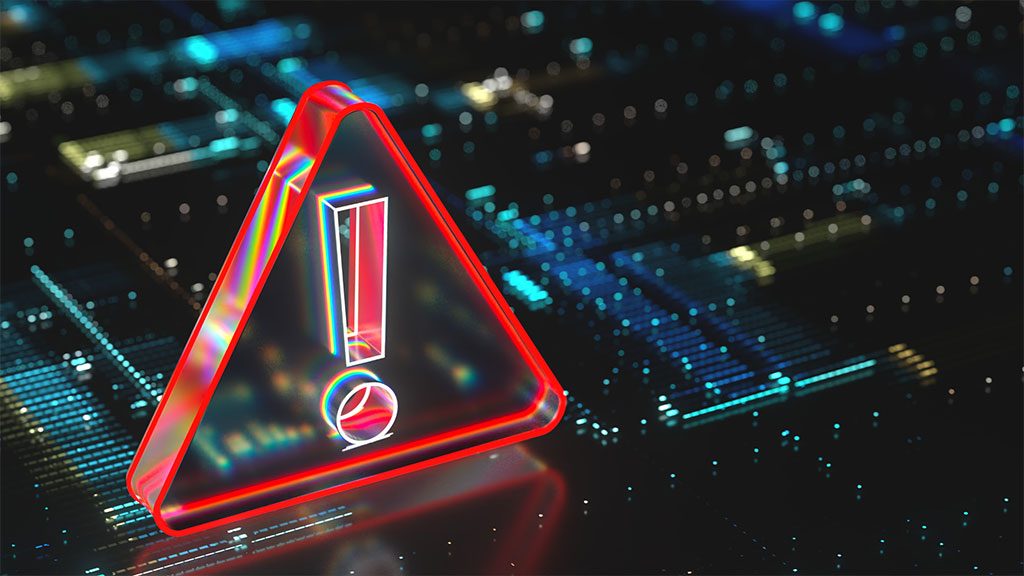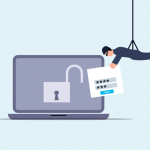
This is one of the sneakiest cybercrime tactics yet. You’re at your PC working when you see a Windows update prompt. Since you want to keep your device safe, you take care of it quickly, but when you install what you think is a legitimate update, you immediately get infected with ransomware.
This tricky new Cybersecurity threat can quickly turn into a nightmare.
We often compare cybercrime to a game of ‘Whack-Mole’, and as fast as you close off one avenue of attack, they devise new ways to infiltrate your system. This new mole that just popped up is very dangerous. They encrypt valuable data, leaving victims with difficult choices. Once ransomware infects your system, your PC (and possibly your entire network) is rendered useless. Your choices: either pay a ransom or get someone to remove the malware, wipe the infected devices, and reinstall the data from your secure backup system (if you have one!).
This new variant that has emerged recently is the ‘Big Head’ ransomware. It adds a new layer of deception by disguising itself as a Windows update. Let’s explore the ins and outs of Big Head ransomware, including its deceptive tactics. We will show you the protective measures you can take to keep yourself from falling victim to such attacks.
What is the big head ransomware?
Everybody should know what standard Ransomware is by now, and what it does: Once an untrained user clicks on a malicious link or attachment in an email, the system locks up and encrypts your data. This renders them inaccessible to the victim until a ransom is paid to the attacker. In the case of Big Head ransomware, the attackers have taken their tactics to the next level. The attack masquerades as a Windows update, a familiar alert that users have come to trust implicitly.
These fake Windows update alerts look authentic and convincing, but they are designed to trick users, who think that their computer is undergoing a legitimate Windows update. The message may appear in a pop-up window or as a notification.
This deception is deeper than previous tactics, as the ransomware uses a forged Microsoft digital signature which makes the fake update appear more authentic. This adds an extra layer of credibility to the malicious message and makes it even more challenging for users to discern its true nature.
Once the user unknowingly downloads and executes the update, the ransomware rapidly floods their system. From there, the ransomware proceeds to encrypt the victim's files. Victims see a message demanding a ransom payment in exchange for the decryption key.
By 2031, it’s expected a ransomware attack will occur every 2 seconds.
How to Protect Yourself from Big Head Ransomware & Similar Threats
The sophistication level in cyber threats is growing exponentially – just as Cybersecurity has become more sophisticated. Crooks are exploring the uses of ChatGPT. It's crucial to take proactive steps to protect your data and systems. Here are some strategies to safeguard yourself from ransomware attacks like Big Head.
Keep Software and Systems Updated!
Part of the cure for fake updates are real updates. Updating your computer is always a best practice for security. It can get tricky since Big Head ransomware leverages the appearance of Windows updates.
One way to be sure you’re installing a real update is to automate. Automate your Windows updates through your device or an IT services provider (like us). This Improves your chances of spotting a fake that pops up unexpectedly.
Verify the Authenticity of Update
File this in the ‘DUH!’ folder. Before installing any software update, verify its authenticity. Genuine Windows updates will come directly from Microsoft's official website. Or through your IT service provider or Windows Update settings. Be cautious of unsolicited update notifications. Especially those received via email or from unfamiliar sources.
Backup Your Data
This should be done already. Regularly back up your important files. Use an external storage device AND a secure cloud backup service. In the event of a ransomware attack, having backup copies is vital. Backups of your data can allow you to restore your files without paying a ransom.
Deploy Robust Security Software
Install reputable antivirus and anti-malware software on your computer. These programs can help detect and block ransomware threats. This helps prevent them infiltrating your system.
Educate Yourself and Others
Don’t just count on your IT team to stay informed about the latest ransomware threats and tactics. You need to educate yourself and your colleagues or family members as well. Discuss the dangers of clicking on suspicious links or downloading attachments from unknown sources.
Use Email Security Measures
Phishing emails are the predominate vehicle for Ransomware attacks, so have in place robust email security measures. Be cautious about opening email attachments or clicking on links. Watch out for emails from unknown senders.
Enable Firewall and Network Security
Activate your computer's firewall. Use network security solutions to prevent unauthorized access to your network and devices.
Disable Auto-Run Features
This is a key defense. Configure your computer to disable auto-run functionality for external drives. This can help prevent ransomware from spreading through infected USB drives.
Be Wary of Pop-Up Alerts
Microsoft and other reputable software developers do not use surprise pop-ups for their alerts. Exercise caution when encountering any and all pop-up alerts. Especially those that ask you to download or install software. Verify the legitimacy of such alerts before taking any action.
Maintain System Vigilance
Keep an eye on your computer's performance and any unusual activity. If you notice anything suspicious, investigate immediately. Suspicious PC activity can be:
Unexpected system slowdowns
File changes
Missing files or folders
Your PC’s processor “whirring” when you’re not doing anything
Have an Incident Response Plan (IRP)
In the unfortunate event of a ransomware attack, have a response plan in place, which should be part of your larger Backup & Disaster Recovery plan. Know how to disconnect from the network. Report the incident to your IT department or a Cybersecurity professional. Avoid paying the ransom if possible.
Frequently Asked Questions
What is the top ransomware in 2023?
Although Big Head is gaining steam, the current top spots according to Trend Micro: “LockBit, Clop, and BlackCat are the three prominent ransomware groups with the greatest number of successful attacks in the first six months of 2023. LockBit, which has managed to remain as the top ransomware family since 2022, accounted for 26.09% of the total number of victim organizations.
What is the best way to backup your data?
These are the three essential backups:
Local Backup: Located in the office, but not connected to the main network.
Cloud Backup: Use a reliable service, but the security is for you to ensure.
Cloud to Cloud Backup: Even clouds get hacked – add this extra protection.
What is the best anti virus program?
According to Forbes, the best overall Anti-Virus (AV) for 2023 is Bitdefender. This may or may not suit your needs to a Tee. Forbes rates the Top 10 HERE.
Is Microsoft firewall good enough?
It depends. You can use the Windows Defender firewall for personal use, but for business computers containing sensitive data you should have comprehensive coverage to protect your company against data threats. Having an overall security policy will help, but you must also consider the most common security attacks. As with the AV in the FAQ above, Bitdefender is at the top of the list.
How secure is your network?
As a reputable member of the IT Support Los Angeles community since 2002, IT Support LA offers a FREE, no-risk network and security assessment. It is a non-intrusive scan that allows us to deliver a comprehensive report that is yours to keep. No strings, and no obligation to ever use our Managed IT Services.
The best defenses are expert Cybersecurity to protect your data from theft, and a top-notch Managed Services Provider to ensure continued reliability and defenses against newly emerging threats.
With our 100% Money Back Guarantee in writing, we offer a risk-free way for prospective clients to try us out. Because we do not require a ‘hard’ contract, our clients can fire us at any time with 30 days’ notice. We have to be good.
Among the Managed IT services we provide:
IT HelpDesk Service
Onsite IT Support
Cybersecurity
Cloud migration and management
Email migration services
Backup and disaster recovery
VoIP phone systems
IT disposition and recycling
Office moves
White label services (IT to IT)
IT Support LA is an award-winning Managed Services Provider (MSP):
o 3 Years awarded Best IT by the Small Business Expo
o Awarded 2nd best company of any type in the US by the Small Business Expo SB100
o Awarded Best IT Support in California by Channel Futures
o Winner of Best IT in Los Angeles by Channel Futures
o Listed as one of the world’s Top 501 MSPs by CRN and in the top 250 in the ‘Pioneer’ listing
o 4 years listed as one of the Top 501 MSPs in the World by Channel Futures
o Listed as #21 MSP in the World in Channel Futures NextGen 101
o Globee 2021 Bronze Award winner for Chief Technology Officer of the Year
o Globee 2022 Gold Award winner for Chief Technology Officer of the Year
o Named one of 2022’s 50 ‘Best’ businesses in California by UpCity
o Named one of 2023’s 50 ‘Best’ businesses in California by UpCity
o Named Best of IT Services winner by UpCity
o Winner of Local Excellence Award for 2021, 2022 and 2023 by UpCity
o Named Best of Cloud Consulting winner by UpCity
o Certified as Top Managed Services Provider and Cybersecurity Pro by UpCity
o Named Best IT Services in Los Angeles by Expertise.com.
Need a Cybersecurity Assessment?
Don’t leave unknown threats lurking in your system. Our FREE network and security risk assessment can shed light on your system vulnerabilities. It's an important proactive measure to ensure network security.
Give us a call today to schedule a chat.
818-805-0909


